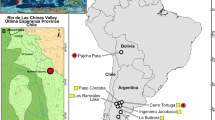Abstract
WITH few exceptions, tooth shape among crocodyliform reptiles (Crocodylia of traditional use) is rather uniform1. We report here on the presence of multicuspid molariform teeth in a remarkable new crocodyliform from the Lower Cretaceous of China, which may represent the first known herbivorous member of that group. The overall structure of these teeth is very similar to that of the postcanine teeth of tritylodontid synapsids and represents a particularly striking example of convergent evolution. It indicates back-to-front (proal) motion of the mandible produced by the posterior pterygoid muscle during jaw closing, much as in the extant tuatara, Sphenodon2,3. Certain derived features indicate that the new Chinese crocodyliform is closely related to the Notosuchidae from the Cretaceous of Gondwana4. Its discovery thus casts further doubts on claims5 concerning an endemic Gondwanan tetrapod fauna during the Cretaceous.
This is a preview of subscription content, access via your institution
Access options
Subscribe to this journal
Receive 51 print issues and online access
$199.00 per year
only $3.90 per issue
Buy this article
- Purchase on Springer Link
- Instant access to full article PDF
Prices may be subject to local taxes which are calculated during checkout
Similar content being viewed by others
References
Langston, W. Jr in Biology of the Reptilia Vol. 4 (eds Gans, C. & Parsons, T. S.) 263–284 (Academic, New York, 1973).
Gorniak, G. C., Rosenberg, H. I. & Gans, C. J. Morph. 171, 321–353 (1982).
Wu, X.-c. thesis, McGill Univ. (1991).
Gasparini, Z. B. de Ameghiniana 8, 83–103 (1971).
Bonaparte, J. F. Actas IV Congr. Argentino Paleont. Bioestrat. 2, 63–95 (1986).
Hao, Y. et al. Stratigraphy of China, Vol. 12: The Cretaceous System of China (Geological Publishing House, Beijing, 1986).
Benton, M. J. & Clark, J. M. in The Phylogeny and Classification of the Tetrapods Vol. 1 (ed. Benton, M. J.) 295–338 (Clarendon, Oxford, 1988).
Wu, X.-c., Brinkman, D. B. & Lü, J. J. vert. Paleont. 14, 210–229 (1994).
Clark, J. M., Jacobs, L. L. & Downs, W. R. Science 244, 1064–1066 (1989).
Krause, D. W. Paleobiology 8, 265–281 (1982).
Sues, H.-D. Bull. Mus. Comp. Zool., Harvard Univ. 151, 217–268 (1986).
Schumacher, G.-H. in Biology of the Reptilia Vol. 4 (eds Gans, C. & Parsons, T. S.) 101–199 (Academic, New York, 1973).
Busbey, A. B. J. Morph. 202, 99–127 (1989).
Sereno, P. C., Wilson, J., Larsson, H. C. E., Dutheuil, D. B. & Sues, H.-D. Science 266, 267–271 (1994).
Author information
Authors and Affiliations
Rights and permissions
About this article
Cite this article
Wu, Xc., Sues, HD. & Sun, A. A plant-eating crocodyliform reptile from the Cretaceous of China. Nature 376, 678–680 (1995). https://doi.org/10.1038/376678a0
Received:
Accepted:
Issue Date:
DOI: https://doi.org/10.1038/376678a0
This article is cited by
Comments
By submitting a comment you agree to abide by our Terms and Community Guidelines. If you find something abusive or that does not comply with our terms or guidelines please flag it as inappropriate.



